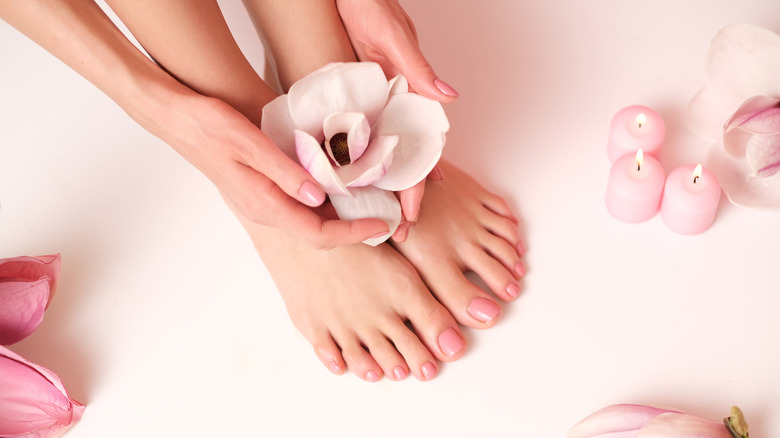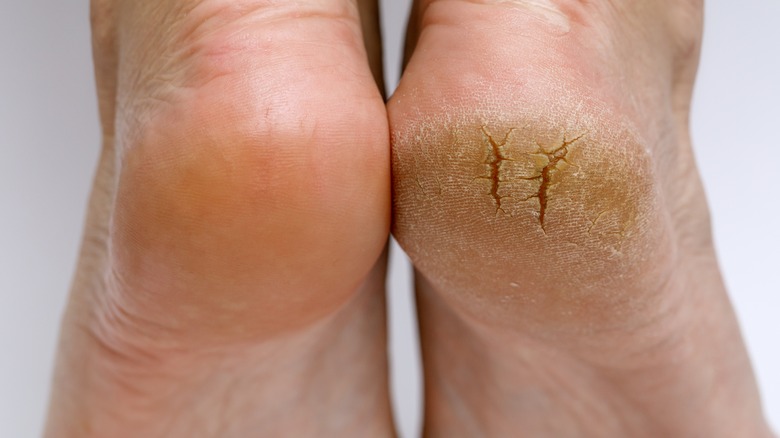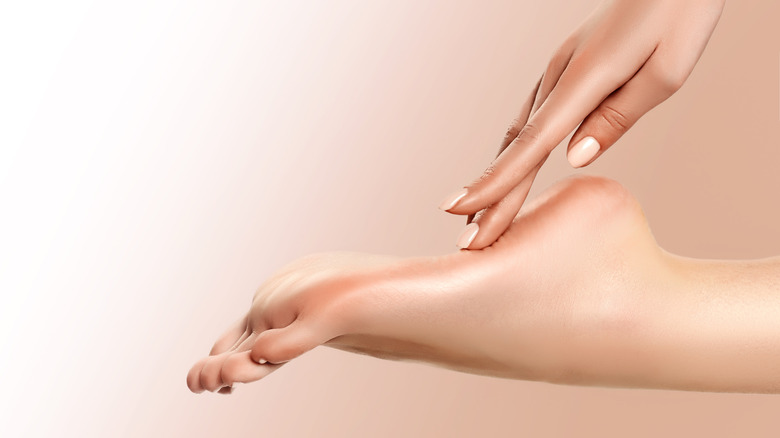What's Really Happening When You Do An Exfoliating Foot Peel?
Back in the day, getting rid of calluses and dry feet involved using a pumice stone or grater tool and some elbow grease to really get your feet baby-soft. Adding some lotion and letting your feet sit in the moisture with some socks made your tootsies good as new. As the Cleveland Clinic explains, calluses are caused by the friction of standing, walking, and using our feet all of the time, causing the skin to thicken. Using something like a pumice stone is great because it rubs off the tough layer of thick skin so that your lotion can penetrate your skin and moisturize.
However, in recent years the foot peel sock has become quite popular. A lot of this popularity is due to the fact that the peel went viral several times thanks to the way it causes your skin to come off in chunks and makes you look like you're a shedding snake. Instead of just rubbing the calluses off like you would with a pumice stone, the foot peel penetrates into the thick skin and causes the dead skin to peel away, allowing new skin to grow. But how does a foot peel really work? Is it even healthy to have that much skin come off like that?
Foot peels use acids to get through calluses
Foot peels often come in one pair of "socks" — little plastic bags in the shape of socks. They're filled with a goopy solution and you're supposed to sit with the socks on for about 90 minutes, or however long the instructions state. Once they're off, your feet will start shedding like crazy a week or so later. The key to foot peels is what's in the goopy stuff.
Dermatologist Dr. Shilpi Khetarpal told the Cleveland Clinic that instead of physically exfoliating your skin, foot peels chemically exfoliate. And that goopy jelly that your feet steep in holds exfoliating acids, typically comprised of alpha hydroxy acid, glycolic acid, or lactic acid, depending on the foot peel you are using. Those acids exfoliate your skin and new skin grows where calluses used to be.
Dr. Chris G. Adigun, a board-certified dermatologist explained to HuffPost that, "Alpha hydroxy acids like glycolic, lactic, citric and malic acids prevent the top layer of the epidermis from sticking together. Beta hydroxy acids like salicylic acid work to dissolve the adhesive holding thickened skin cells together." If that sounds intense, it is, which is why The Guardian suggests only doing a chemical foot peel a handful of times per year. Dr. Khetarpal said this is because you now have new skin where the old, dead skin was and calluses shouldn't appear quicker than a few months at a time.
Foot peel do's and don't's
Regarding the foot peel's intensity, there are some people who shouldn't go near those jelly-filled socks. According to Shape, people with open infections shouldn't use them. Khurram Khan, an associate professor at the New York College of Podiatric Medicine, told The Ringer that diabetics shouldn't either because they tend to experience a loss of sensation, so a foot peel could give them ulcers or sores. These could potentially get so bad that they'd need an amputation. Pregnant people shouldn't use foot peels either because skin goes through a lot of hormonal changes during pregnancy, making it more sensitive, per One Medical.
But anyone can experience adverse reactions to a chemical foot peel, according to Dr. Louise Reaney, a longtime podiatrist, and her daughter Emily Sharp. Per Newsweek, Reaney explained that the salicylic acid in the jelly is good for removing calluses, but that the socks can also remove skin that doesn't need to be removed. This can really dry feet out, leading to cracks and distressed skin, rather than "baby-soft" feet.
If you do use the foot peel, don't peel the freaky-looking peeling skin on your own because you could end up breaking skin if it's not ready to peel. Dr. Chris G. Adigun told HuffPost that you should let them peel off naturally. If you don't want all of that gross skin to make a mess in your bed at night, wear socks throughout the night.


